|
|
Queen Mary

|
|
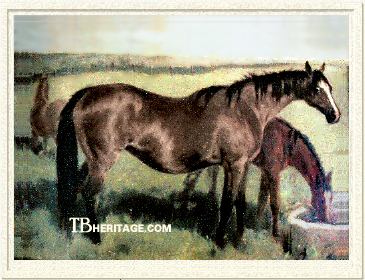 |
|
|
Queen Mary is one of the most influential broodmares of the 19th Century, and established a family of vast importance in the production of classic winners and stallions that flourished for the next century and more.
Her sire was Gladiator (1833), by Partisan, an extremely influential sire. Besides Queen Mary, his most important offspring was the stallion Sweetmeat, and he also got the Prix du Jockey Club winners Ventre Saint-Gris and Celebrity as well as the sire Fitz Gladiator. Queen Mary's dam was an unnamed daughter of the Derby winner Plenipotentiary, whose best runners were the fillies Poison (Oaks) and Potentia (1,000 Guineas). This unnamed daughter never raced and was bred when just 2 years old. Queen Mary was her first foal, and she produced nothing of note otherwise.
The General Stud Book shows Queen Mary as being bred by Mr. Dennis, who had retained the services of William I'Anson as trainer. I'Anson, a Scot, maintained a training yard at the Spring Cottage Stables, Malton, Yorkshire. The Gladiator filly made only one start as a 2-year-old, at Chester, but went down during the running and suffered injuries that forced the end of her racing career. Dennis gave Queen Mary to I'Anson, who bred her as a 3-year-old in 1846 to Mango, but she did not conceive. She was bred later the same season to Lanercost, producing a small, unimpressive brown filly in the spring of 1847. Queen Mary was bred back to Mango and the next year produced a filly foal which died at a very early age. In 1849, Queen Mary produced a bay filly by Moss Trooper that was as uninspiring as the mare's first foal.
That one, since named HARICOT, was not progressed enough to put into training at 2. I'Anson had little encouragement to continue breeding from Queen Mary, and after she foaled a bay colt by Annandale in the spring of 1850, she was sold for 40 pounds to a farmer in Forfarshire (Scotland). I'Anson used her 3-year-old daughter as a riding horse until he realized that HARICOT had some speed, and he quickly tested the depths of her ability. She made 17 starts at 3, winning 10. He continued to race her hard at 4, 5, and 6, and she proved herself a mare of exceptional class and durability, winning 17 races in 40 lifetime starts. Her wins included the Lincolnshire Handicap, Manchester Cup, and Stirling Gold Cup. She also placed a notable second to the great champion Voltigeur in the Flying Dutchman Handicap.
|
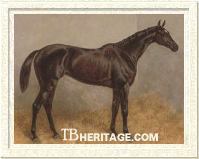
Caller Ou, from daughter Haricot
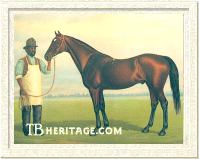
Queen Mary's son, Bonnie Scotland, became a significant sire in the U.S.
| Queen Mary's Foals |
| Offspring |
Sire |
| Haricot, br.f. 1847 |
Mango or Lanercost |
| unnamed f. |
Mango |
| Braxey, b.f. 1849 |
Moss Trooper |
| *Balrownie b.c. 1850 |
Annandale |
| Beef and Greens, b.c. 1851 |
Ferneley (a Clydesdale Stallion) |
| Blooming Heather, b.f. 1852 |
Melbourne |
| *Bonnie Scotland, b.c. 1853 |
Iago |
| Blink Bonny b.f. 1854 |
Melbourne |
| missed (1855) |
Touchstone |
| Balnamoon b/br.c. 1856 |
Annandale |
| Bab at the Bowster b.f. 1857 |
Annandale |
| Bonnyfield, b.c. 1858 |
West Australian |
| Bonny Breast Knot, br.f. 1859 |
Voltigeur |
| Bonny Bell, b.f. 1860 |
Voltigeur |
| Broomielaw, b.c. 1862 |
Stockwell |
| Bertie b.c. 1863 |
Newminster |
| Blinkhoolie, b.c. 1864 |
Rataplan |
| Bertha b.f. 1866 |
Young Melbourne |
| Bonnie Doon, b.f. 1870 |
Rapid Rhone |
| |
HARICOT'S surprising turnaround from hack to racehorse made I'Anson feel a bit like a fool for having sold her dam so cheaply. He went back to the farmer in Forfarshire, only to discover that he had bred Queen Mary to a "bonny" Clydesdale stallion named Fernely and had resold her. The mare was finally tracked down, "running loose in Caledonia," and I'Anson paid 100 pounds to buy her back carrying a foal he would have to write off as a half-bred.
Little Haricot herself produced a dozen foals for I'Anson, including Caller Ou, her 1858 filly by Stockwell. Caller Ou was even more durable than her dam, making 86 starts over 6 years of competition, posting 44 wins. As a 3-year-old, she won the St. Leger Stakes at Doncaster. Haricot also produced Lady Langden (1868 by Kettledrum), famous as the dam of Derby winner Sir Bevys and the important runner and sire Hampton.
Queen Mary's Moss Trooper filly of 1849 was named BRAXEY, and she was similar to HARICOT, being small and unattractive. Although not in the same class as a racehorse, Braxey managed to win the Stirling Stakes in 1854. Braxey produced three particularly good daughters. Thrift (by Stockwell) was the dam of Arc de Triomphe and Ascot Gold Cup winner Tristan. *Bernice (by Stockwell) was imported to America by August Belmont I and became an important broodmare for him, dam of stakes winners Bertram and Beatrice, two of the best runners sired by Kentucky. Merino (by Young Melbourne) became the granddam of Oaks winner La Roche.
Queen Mary's 1850 colt by Annandale was named BALROWNIE. He was a good stayer, winning the Doncaster Stakes, Pontefract Gold Cup, Caledonian St. Leger, and Kelso Stakes. Sent to America, he stood in New York and New Jersey. Although not a great success, he sired several good daughters. Attraction (1866) produced August Belmont's mare Magnetism, herself dam of stakes winners Magnetizer, Magnate, and Magian. Another daughter, Heatherbelle, was the dam of Viator. A third, Bonnie Doon, was the second dam of champion Ramapo.
The Clydesdale-sired colt Queen Mary foaled on her return to I'Anson's paddocks at Malton in 1851 was named "BEEF AND GREENS." His fate is unknown. After she foaled Beef and Greens, Queen Mary found herself keeping entirely different company, since the efforts of HARICOT had earned her a trip to be bred to the high class stallion Melbourne. This resulted in the bay filly, BLOOMING HEATHER, born in 1852. Blooming Heather was a winner and also ran second in the 1855 Oaks to Marchioness. Blooming Heather had several good daughters, but the most important line descending from her was through her daughter Mahonia, the fifth dam of the great steeplechase champion Battleship.
|
In 1852, Queen Mary was bred to I'Anson's good runner Iago, and foaled *BONNIE SCOTLAND the next spring. Injured at 2, *Bonnie Scotland became a stiff competitor at three, winning the Doncaster Stakes and Liverpool St. Leger, and placing second (in a dead-heat) in the Doncaster St. Leger before unsoundness forced his retirement. He stood one season in England before being sold to American interests in 1857. After standing in Ohio and Illinois and siring a surprising number of top class runners despite the lack of quality mares, he was purchased to stand at Belle Meade Stud in Tennessee for the 1873 season. Belle Meade was one of the top farms in the country and here, *Bonnie Scotland reached the greatest heights. He was America's Leading Sire in 1880 and 1882, and sired champions Luke Blackburn, Bramble, George Kinney, and the mare Bourbon Belle (dam of the champion and great sire Hanover).
Blink Bonny
After *Bonnie Scotland, Queen Mary was returned to Melbourne, and produced a bay filly in 1854 that was to do more to make her reputation than any other. Named Blink Bonny, the filly was also a small foal, as Queen Mary's fillies tended to be, but she made up for it with a tremendous hindquarter and mid-section. As a 2-year-old, BLINK BONNY made 11 starts, winning 8 including the Gimcrack Stakes and became the winter favorite for the Derby. Unfortunately, Blink Bonny had serious dental
problems, making it difficult to keep her in condition. To compensate for her inability to properly chew her food, she was fed the choicest of tender clover by hand, and with extra care, matured into one of the greatest 3-year-old fillies of all time.
|
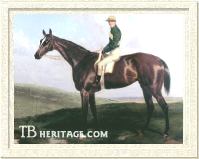
Dual classic-winning daughter Blink Bonny
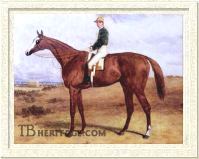
Blink Bonny's Triple Crown winning son, Blair Athol
| |
As a 3-year-old, the blazed-faced bay filly won 5 of her 7 outings, including the Derby and the Oaks. In the Derby, she faced 35 runners, 8-12 false starts, but still won by a neck in a blanket finish at odds of 20-1. Two days later, she won the Oaks by 8 lengths. Her only losses that season were in the 1,000 Guineas and the St. Leger, both won by the filly Imperieuse. In the latter, BLINK BONNY'S jockey, John Charlton was generally presumed to have been paid to lose. He held her and she ran fourth. Two days later, Blink Bonny returned to win the Park Hill Stakes, the filly equivalent of the St. Leger, in a time quicker than that posted by Imperieuse in the St. Leger itself, which caused a furor. The great filly raced twice at 4, winning once more, and retired with a total of 20 starts, 14 wins.
BLINK BONNY'S first foal was the filly Borealis (1860 by Newminster), who placed third in the Oaks of 1863. Her next effort was Blair Athol (1861 by Stockwell), a bald-faced chestnut colt who won the English Triple Crown. As a stallion, Blair Athol extended Queen Mary's influence even further, as leading sire in Great Britain and Ireland in 1872, 1873, 1875, and 1877. He sired classic winners Silvio (Derby, St. Leger), Craig Millar (St. Leger), Prince Charlie (2,000 Guineas; sire of American champion Salvator), Cecilia (1,000 Guineas), and Scottish Queen (1,000 Guineas). |
Blair Athol's brother, Breadalbane (1862) was purchased from I'Anson by Henry Chaplin (of Blankney) in a package with the closely related Broomielaw (1862 by Stockwell - Queen Mary). Breadalbane sired *The Ill-Used (a good stakes winner and a Leading Sire in America), Flower of Dorset (dam of Friar's Balsam, sire of *Voter and dam's sire of Minoru), Bella (dam of Heaume), and Sarcasm (third dam of Flying Fox) among his most influential offspring. Blink Bonny died young and I'Anson gifted her skeleton to the museum in York for posterity.
After foaling Blink Bonny, Queen Mary was bred to the great stallion Touchstone, but did not conceive, the first time in 8 years she didn't have a foal. Returned to Annandale (by Touchstone), she had the 1856 colt, Balnamoon, which left no mark. In 1857, she foaled BAB AT THE BOWSTER, a filly by Annandale, from which descend the classy runners Fenek (in Germany), Valerius (in Italy), and Flying Juliet (in Australia). Queen Mary's 1858 colt, Bonnyfield (by West Australian) did little of note. Her 1859 foal, the filly Bonny Breast Knot (by Voltigeur) produced Sheldrake (1874 c. by Mandrake).
Returned to Voltiguer, Queen Mary foaled BONNIE BELL in 1860. Like her dam and several of her sisters, Bonny Bell was an extremely prolific broodmare, producing 17 foals that lived. The best of these was Beauclerc (1875 by Rosicrucian), winner of the Middle Park Plate. I'Anson kept Beauclerc as a stallion at Blink Bonny Stud, and there he got Tyrant, a sire in France, who in turn got Masque, sire of classic winners Medeah and Vinicius. Beauclerc's daughter, Matilda, produced the sires Nunthorpe and Queen's Birthday. Another daughter, the Empress Maud, was the dam of Knight of the Thistle.
|
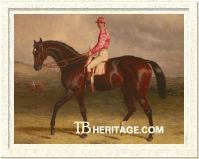
Broomielaw
| |
Queen Mary's 1862 colt, BROOMIELAW (by Stockwell) was sold (along with Breadalbane, noted previously) to Henry Chaplin. Infamous for his bad temperament, despite his antics, his wins included the Goodwood's 1866 Chesterfield Cup. Broomielaw proved an influence through his daughter Doll Tearsheet, dam herself of the Derby winner Merry Hampton (sire of the second dam of Man o'War) and his half-brother Gay Hermit (who became an important sire in Argentina). |
BERTIE, a Newminster colt foaled in 1863, did nothing of note, but the next year Queen Mary dropped BLINKHOOLIE (by Stockwell's brother Rataplan), perhaps her best racing son. Foaled when his dam was 21 years old, Blinkhoolie won the Gimcrack Stakes, Queen Alexandra Stakes, and Ascot Gold Vase. Although he died young, he left a significant mark as a sire. His most important son was Wisdom (1873), sire of Sir Hugo (Derby), La Sagesse (Oaks), Surefoot (2,000 Guineas), and Love Wisely (Ascot Gold Cup) to name just a few. Blinkhoolie's daughter Nameless produced Oaks winner Geheimniss. Daughter Yessel was the dam of the important broodmare Yesterling (dam of Ouadi Halfa).
In 1866, Queen Mary foaled the filly BERTHA (by Young Melbourne), who was not an important runner or broodmare. Age was beginning to tell on the old matron, and Queen Mary then missed 4 years of production from 1867 to 1869.
But the old girl wasn't finished. In 1870, at the age of 27, she produced BONNIE DOON, a filly by Rapid Rhone. Bonnie Doon was sold to Henry Chaplin, for whom she became a top producer. Her daughter Wharfedale (by Hermit) produced Watercress, a stakes winner and good sire when imported into America, sire of Watervale (Preakness), Nasturtium (champion at 2), Rhine Maiden (Preakness), and the best of them all, Waterboy, an outstanding handicapper. |
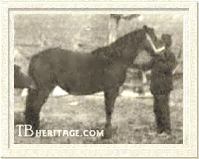
Imported Bonnie Gal, the dam of Disguise, was a daughter of Queen Mary's last foal, Bonnie Doon.
| |
BONNIE DOON'S daughters *Bella-Donna (by Hermit) and *Bonnie Gal (by Galopin) were both imported and proved extremely important broodmares in America. For August Belmont II, *Bella-Donna produced the great race mare Beldame, Preakness winner Don Enrique, as well as stakes winners Don Diego and Don de Oro. Another daughter, Bellamia, is the tail-female ancestress of Canadian champions or leading sires Viceregal, Vice Regent, and Victoria Park. Belmont was obviously enamored of Queen Mary blood, since he also imported and stood *The Ill-Used (by Breadalbane). [His father, August Belmont I had owned the foundation mares, Attraction, by *Balrownie, and *Bernice, a daughter of Braxey.] |
*Bonnie Gal was imported by James R. Keene, who bred the outstanding colt Disguise, who also became a top sire, as well as his half-sisters Belgravia (dam of Black Toney) and Coy Maid (dam of 4 stakes winners). Through Black Toney and Disguise, *Bonnie Gal's influence has been far-reaching.
Bonnie Doon proved to be Queen Mary's final foal, and the great mare died 2 years later, in 1872, at the age of 29. In all, Queen Mary had 20 foals, which is remarkable in itself, and all were bays, indicating that she was a pure-breeding bay. Even more remarkable is the fact that her offspring included not just one top runner, but several good ones, who not only ran well, but also bred on with importance: Haricot, Blink Bonny, Broomielaw, Bonny Bell, Blinkhoolie, and Bonnie Doon. Queen Mary's family threw exceptional class and durability. Its many daughters, with a few exceptions like Blink Bonny, proved fertile and long-lived. She and her daughters were responsible for producing some of the best runners by the best sires of the time: Stockwell (Caller Ou, Blair Athol), Melbourne (Blink Bonny), Iago (Bonnie Scotland), and Rataplan (Blinkhoolie).
That's a long way from running wild on a rocky hillside in Caledonia in foal to a Clydesdale stallion.
--Anne Peters
|
|
|
|

